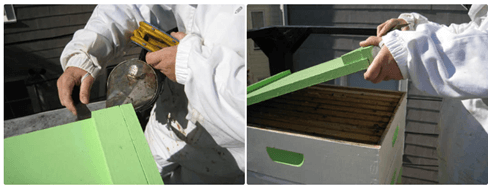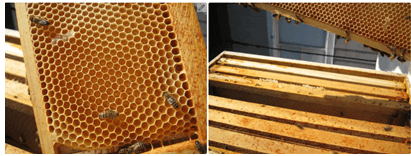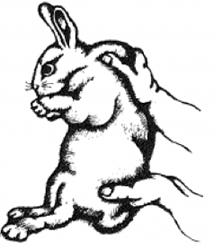
Animal Handling
Forms Of Animal Handling (humane Methods)
The objective of humane animal handling is to move animals with minimum stress to both the animals and handler. Considerate handling reduces the risk to the animal of pain, injury and suffering.
Planning the restraint procedure
When preparing to restrain a patient, always make sure the area has enough room, is clean, dry, and well lit
- A plan should be discussed:
- Move any costly equipment
- Nonslip area
- Temperature should be considered
- What should be done if animal happens to get away from restrainer
- Back up plan (Plan B!)
Rabbit Restraint & Handling
Picking Up
Grab scruff of the neck with one hand and lifting up while placing the other hand under the rump for support or wrap patient securely in a towel.
Holding
Use the same technique but the hand under the rump is moved to support the abdomen.
Rabbits seldom bite but many cause injury with their hind legs or may be injured if placed on a smooth surface
Rabbit’s foot pads are covered with fur which causes a lack of traction
Can lead to dislocation of their hip or spinal fracture, when they try to move or hop
Rodents Restraint & Handling
Mice
Grasp the tail close to the body with one hand
Use the other hand to grasp loose skin in the neck and shoulder area.
Larger Rodents and Ferrets
Make sure the animal is awake to avoid bites
Hold in one hand, cup other over its head
Wrap thumb and index
finger around neck and under chin
Do not over tighten fingers around chest as this can impair breathing

Avian Restraint
Birds
Highly trained personnel
Can stress easily
Do not squeeze thorax
Sensitive to overheating
Small to medium sized
Grasp from behind, finger and thumb on sides of head, others around body
Large birds require 2 hands
Towel can also be used

Cats Restraint & Handling
Cats tend to be one of the most difficult during restraint when they become upset and aggressive from stress
Safely restrain and have control over head
Cat bags: control the limbs and head
Squeeze cages: wire boxes with small slots that allow injections to be given

Inhuman handling of animals in the community

Solutions to animal’s mistreatment
- Be an example of kindness to other pets. ...
- Intervene if you witness animal cruelty, abuse or neglect. ...
- Report animal cruelty, abuse or neglect. ...
- Teach your children to have respect for animals. ...
- Demand stricter laws for the protection of animals. ...
- Shelter an animal in need.
Importance Of Human Treatment Of Animals
- Improved levels of animal health and care will deliver better animal welfare, more efficient livestock production, safer animal-sourced foods and healthier, improved livelihoods.
- Animals that are well fed and watered, kept in clean and comfortable conditions, and that are handled well with opportunities to express important behaviours are less likely to die prematurely or show poor growth than less well cared for animals.
- They are more productive with more efficient use of resources such as time, labour and feed for livestock production bringing benefits including improved food security and greater income.
- Furthermore, avoiding stress before slaughter reduces contamination of meat with harmful bacteria and affects the quality, and value of the meat.
- Animal welfare is therefore also environmental protection. However, it is not only animals in stables or private households that need to be protected, but also animals in the wild. There they need above all plenty of space, clean water, fresh air, and sufficient food and shelter.

General Management of Pets
Characteristics Of Pets
- Dependent on Humans to Live – A pet needs to be given food, water, and shelter by its owner. Being domesticated means the animal depends on its owner for all of its care.
- Lives in a Home – A pet lives in a home. Some pets such as parakeets and hamsters live in cages. Alternatively, dogs and cats wander freely around a home and may have their own bed to sleep in.
- Needs a Veterinarian’s Care – Pets need care from a veterinarian. The type of healthcare a pet needs depends on what type of pet it is. An iguana and a beagle need completely different types of vet care!
- Some Pets Can Be Trained – A dog can learn how to sit, stay, and heel in a course of obedience training. Parrots can be taught to talk, and some cats can be taught by humans to do tricks.
- Devoted to Its Owner – Pets are often devoted to their owners. They can establish a trust with their owner over time. In fact, some pets want to be with their owners 24/7!
- Provides Companionship – A pet is meant to be a companion to its owner.
- Pets are Different from a Therapy Animal – A therapy animal receives specific training in order to provide support and care to its owner. As an example, some therapy dogs are trained to recognize the signs of a seizure in their owner. The dog responds by trying to get the person to a safe place. Alternatively, a pet is there strictly as a companion.
- Different from a Farm Animal – A cow or a chicken living on a farm serves a specific purpose. A cow provides milk while a chicken lays eggs to be eaten or sold. This makes farm animals a little different than traditional pets.
- Can Be Common or Uncommon – When you think of a pet you probably picture a dog, a cat, a bird, a fish, or a gerbil. Those are common choices for pets. Some people prefer less common or exotic pets such as snakes, iguanas, spiders, and ferrets. As long as an owner can offer appropriate care, many animals can live happily as pets.
- Cannot Survive in the Wild – One of the main characteristics separating pets from other animals is a pet can’t survive in the wild. It has been domesticated or raised under a person’s care. So, releasing a pet snake into the wild doesn’t mean it will know how to find food or shelter. In fact, it will likely die.
Different types of pets reared in the community
A pet is a domesticated animal that lives with an individual or family. There are popular, well-known pets like dogs and cats
- Dogs
- Cat
- Rodents
- Fish
- Birds
- Turtles
- Snake
Factors To Consider When Selecting A Pet For Rearing
Choose a pet that will suit your lifestyle and surroundings. For instance:
- How often are you home? If you work long hours, a dog may not be a good choice of pet, as all dogs require lots of companionship. In this case, pets such as fish might be more suitable.
- How large is your backyard, and do you have good fencing? If you have a small backyard or poor fencing, then a dog may not be a good choice. You could consider a pet such as a cat that lives indoors with you.
- Are you prepared to have more than one pet? Some types of animals, such as birds and rabbits, need the company of each other to stay happy and healthy.
- How much money can you afford to spend on your pet? All pets are expensive — even animals that are cheap to purchase, like fish, birds and guinea pigs, can cost a lot of money when it comes to buying and setting up tanks, cages and hutches. Some dog breeds will cost more to keep than others. Large dogs need more food, some breeds of dogs need regular clipping of their coats.
- Are you renting? Your landlord may not let you to own a cat or a dog. You may want to consider other pets such as fish.
- Do you live in an apartment? Some birds, such as parrots, can be very noisy, and may attract complaints from neighbours. You may want to consider a quiet pet such as a cat, or fish.
- Do you have young children? Some types of pets tolerate children better than others.
- Are you prepared to have your pet inside with you? Dogs should not be left in the backyard all day — they need to spend time inside the house with you, in order to remain happy and healthy.
- Does your council require cats to be confined to your property? If so, you must be prepared to have your cat live inside with you, or to buy or build cat proof fencing or a cat enclosure.
- How much time do you have to exercise your pet? Dogs need daily walks. Some breeds of dog are more energetic than others and may need longer or more frequent walks.
- How much time do you have to train your pet? Dogs, particularly puppies or young dogs, need time spent on toilet training and basic obedience training. Puppies and kittens also require lots of socialization, and regular small meals throughout the day, during the first 6 months of life. You may be better off adopting an adult dog or cat, who is already house trained and socialized.
Acquiring a pet for rearing
- Adoption is the best choice
Adoption of a pet from a shelter is the best way to find a new companion. There are many animals in shelters waiting for a new home to call their own, including a large variety of breeds, sizes, and ages of animals. Some shelters also rehome small mammals such as rabbits, guinea pigs and hamsters who are often sadly taken to shelters when the children they have been bought for have lost interest in caring for them. The benefit of rehoming from a reputable animal shelter is that the animals will have been assessed both in terms of their health and behaviorally - Brokers,
- pet stores,
- neighbors,
- professional breeders,
- commercial kennels,
- puppy mills, and animal shelters
Management Practices In Rearing Of Pets
- Colostrum feeding
- Weaning
- Disbudding - Arresting the horn growth at an early age, when the horn root is in the bud stage is called disbudding.
- Ear tagging
- Castration
- Vaccination schedule for adult animals
- Disinfection
- Quarantine
- Isolation of sick animals
- Insuring the animals
- Disposal of carcass
- Record maintenance

Preparation Of Animal Products
Different animal products include:
meat and meat products, poultry products (meat and eggs), fish, shellfish, dairy products (milk and cheese), and non-food products such as fiber (wool, mohair, cashmere, and leather)
Factors To Consider When Grading Eggs
The grade is determined by the
- interior quality of the egg
- the appearance and condition of the egg shell.
- Eggs of any quality grade may differ in weight (size).
- Weight or Volume
- cleanliness
- Size,
- Colour
Factors considered in detecting defects when grading eggs
- blood spot,
- meat spot,
- mold,
- stuck yolk,
- addled egg and
- embryonic growth
Processing Raw Honey
The process of honey harvesting and extraction most likely happens on separate days. These are the tools required:
Honey Harvest
- beekeepers suite - mesh helmet and folding veil would do it, with some layers of clothes
- smoker with fuel (dry branches, leaves, etc.) and a lighter
- frame super - where frames with honey combs will be put for transportation
- sting resistant gloves
- hive tool - to move the frames, scrape wax, etc.
Honey Extraction
- heated knife - to unseal honey cells
- uncapping fork - to unseal honey cells missed by the heated knife
- tub for wax/honey
- extractor! - fancy cylindrical piece of equipment, used to extract honey
- food-grade bucket - to catch honey out of the extractor
- double sieve - catches wax and impurities as honey is poured from extractor
- containers - final destination of honey before consumption
The process of honey harvesting and extraction most likely happens on separate days. These are the tools required:
- Harvesting
Light the smoker. Use dry branches, hay or newspaper. The smoke dulls the bees' receptors, and prevents them from releasing the alarm odor, a volatile pheromone. The smoke also makes bees gorge on honey, which further pacifies them
- Prepare Supers
The frames with honey comb are transported in supers. Have them handy. You may also want to have a cloth to cover the super with frames full of honey to prevent bees or other insects from getting to them.
- Open Sesame

Using the hive tool, lift the hive lid and blow some smoke in the hive. Open lid slowly. Our bees were pretty calm, but that is not always the case! - Honey Frame Inspection
Pull the frames out of the super and inspect the honey combs. Depending on how busy the bees were, how warm it was and if the hive didn't swarm you will know how much honey you have.
- Extraction

Now the best part! Take the frame of capped honey. Mount the frame above the tub for wax and honey. Use the heated knife to unseal the cells. Lean the heated knife on the edges of the frame and under 30 degree angle and move "fast" - don't linger too long, it burns the honey! Repeat for both sides of the frame.
The heated knife takes off most of the caps. For the leftover ones, use the uncapping fork and gently shave off the caps. - Pour Out Slowly!

Place your food-grade bucket under the extractor spigot. Use a double sieve to catch the wax and impurities as the honey starts pouring out of the extractor. - Prepare Containers

Wash your jugs, jars or whatever containers you will put the honey in. Air dry.
Extracting Honey Without A Honey Extractor
For small apiaries, harvesting honey without an extractor can be a fun and inexpensive option. We’ll cover two methods that do not require an extractor: the crush and strain method, and the cut comb method. Both of these extraction methods sacrifice comb, meaning your bees will need to draw out new comb before they can produce more honey — which can mean a smaller harvest the next year. This may factor into your decision about which method you use.
The crush and strain method is a low-cost honey processing technique. You simply scrape the honeycomb off of the frame into a bucket, then crush the comb. Place a sieve in another bucket or container, pour the crushed comb into the sieve, and strain it overnight. This process may be best suited for hobby beekeepers who only have one or two hives. The honey will move more quickly in a warm room, and you may be able to get more honey if you stir the crushed combs a few times and scrape large wax flakes off of the inside of the strainer.
Cut comb honey is an elegant way to package and use your harvest. There are tools available for cutting and packaging comb, but a good-quality kitchen knife does the job nicely, as well. This method works only for frames that contain wireless wax foundation or no foundation — you cannot use this method with frames that use plastic foundations, and wired wax foundation will limit the sizes and shapes of combs you can cut. Choose frames that are fully capped and sealed — this indicates that the honey will have the right amount of moisture to prevent spoiling.
Importance of sorting and grading eggs
- Sorted eggs bring more money to the investor than unsorted.
- It reduces wastage.
- separates eggs into grades of quality.
- A bad egg can be dangerous to consume and negatively affect someone's health.
Importance of processing raw honey
- improves the honey's appearance,
- increases its shelf-life, and
- kills yeast cells that can affect the taste of the honey.
- It can prevent fermentation.
- It delays crystallization.
- removes impurities.
Download Animal Production - Grade 7 Agriculture Revision Notes.
Tap Here to Download for 30/-
Get on WhatsApp for 30/-
Why download?
- ✔ To read offline at any time.
- ✔ To Print at your convenience
- ✔ Share Easily with Friends / Students



